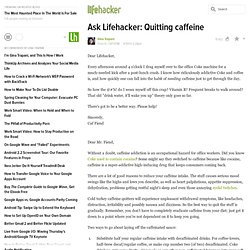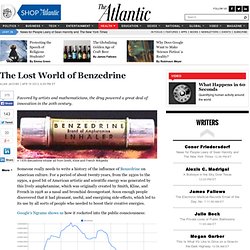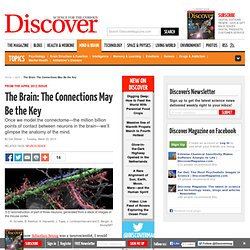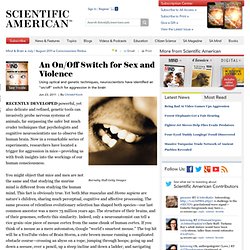

Ask Lifehacker: Quitting caffeine. Dear Lifehacker, Every afternoon around 4 o'clock I drag myself over to the office Coke machine for a much-needed kick after a post-lunch crash.

Health - Alan Jacobs - The Lost World of Benzedrine. Favored by artists and mathematicians, the drug powered a great deal of innovation in the 20th century.

A 1939 Benzedrine inhaler ad from Smith, Kline and French Wikipedia Someone really needs to write a history of the influence of Benzedrine on American culture. How to Increase Dopamine Levels: Foods to Eat and What to Do. Dopamine is the brain’s feel good chemical, sending feelings of well-being and pleasure into your body.

In addition to simply making you feel good, dopamine helps control weight, energy levels, and supports brain and heart health. Without it, we would be more fat, unhappy, and tired. But if you know how to increase dopamine levels, you can take advantage of this feel good chemical on command. The best part? You can increase dopamine levels just by eating certain foods.
Fat, unhappy, and tired—those words seem to fit many Americans quite well. But, how can you boost dopamine levels naturally? Another solution for how to increase dopamine levels and flood your brain with this feel-good chemical is exercise. Blog » Blog Archive » 23 Surprisingly Effective Treatments for Depression (One Year Later) For the live-updated, interactive version of this infographic, click here.

A year ago, we published one of our most popular findings – 6 surprisingly effective treatments for depression. I went ahead and repeated the analysis today, and now we have 23 treatments in the “surprisingly effective” category for depression. This chart is based on 4,956 people with depression who participated in CureTogether surveys, compared to 944 people last year. The top treatments are still exercise, sleep, and talking to others – they are popular and effective ways to feel better when you’re depressed.
Neuroscience. Recovered from psychology & neuroscience. The Age Of Insight. Eric Kandel is a titan of modern neuroscience.

He won the Nobel Prize in 2000 not simply for discovering a new set of scientific facts (although he has discovered plenty of those), but for pioneering a new scientific approach. As he recounts in his memoir In Search of Memory, Kandel demonstrated that reductionist techniques could be applied to the brain, so that even something as mysterious as memory might be studied in sea slugs, as a function of kinase enzymes and synaptic proteins. (The memories in question involved the “habituation” of the slugs to a poke; they basically got bored of being prodded.) Because natural selection is a deeply conservative process – evolution doesn’t mess with success – it turns out that humans rely on almost all of the same neural ingredients as those inveterbrates. Memory has a nearly universal chemistry. Pineal gland. The Brain: The Connections May Be the Key. There was just one problem: Nobody knew what the connectome looked like.

Personality Traits Correlate With Brain Activity. Classification of Emotions. Psychologists have yet to fully tackle the question “How many emotions do we have?” Part of the difficulty is because our experiences are so complex and involve so many different factors, so distinguishing one emotion from another is a lot like drawing lines of sand in the desert. It can be hard to determine where one emotions ends or another begins. Even when we analyze a commonsense emotion like “happiness” or “anger,” we know from everyday experience that these emotions come in many different degrees, qualities, and intensities. In addition, our experiences are often comprised of multiple emotions at once, which adds another dimension of complexity to our emotional experience. Test for Psychopathy. An On/Off Switch for Sex and Violence.
RECENTLY DEVELOPED powerful, yet also delicate and refined, genetic tools can invasively probe nervous systems of animals, far surpassing the safer but much cruder techniques that psychologists and cognitive neuroscientists use to observe the human brain.

Now in a remarkable series of experiments, researchers have located a trigger for aggression in mice—providing us with fresh insights into the workings of our human consciousness. You might object that mice and men are not the same and that studying the murine mind is different from studying the human mind. This fact is obviously true.
Yet both Mus musculus and Homo sapiens are nature’s children, sharing much perceptual, cognitive and affective processing. The same process of relentless evolutionary selection has shaped both species—our last common ancestor was a mere 75 million years ago. Aggression Center Our story starts in the hypothalamus, an ancient region of the brain, conserved throughout mammalian evolution. MIT discovers the location of memories: Individual neurons. Update 12/2/15: We’ve now followed up on this story: The more we learn about memory, the weirder it gets.

The original continues below. MIT researchers have shown, for the first time ever, that memories are stored in specific brain cells. By triggering a small cluster of neurons, the researchers were able to force the subject to recall a specific memory. By removing these neurons, the subject would lose that memory. The Age Of Insight. Consciousness Does Not Reside Here. Amsun. Amsun buzz on Soul science.